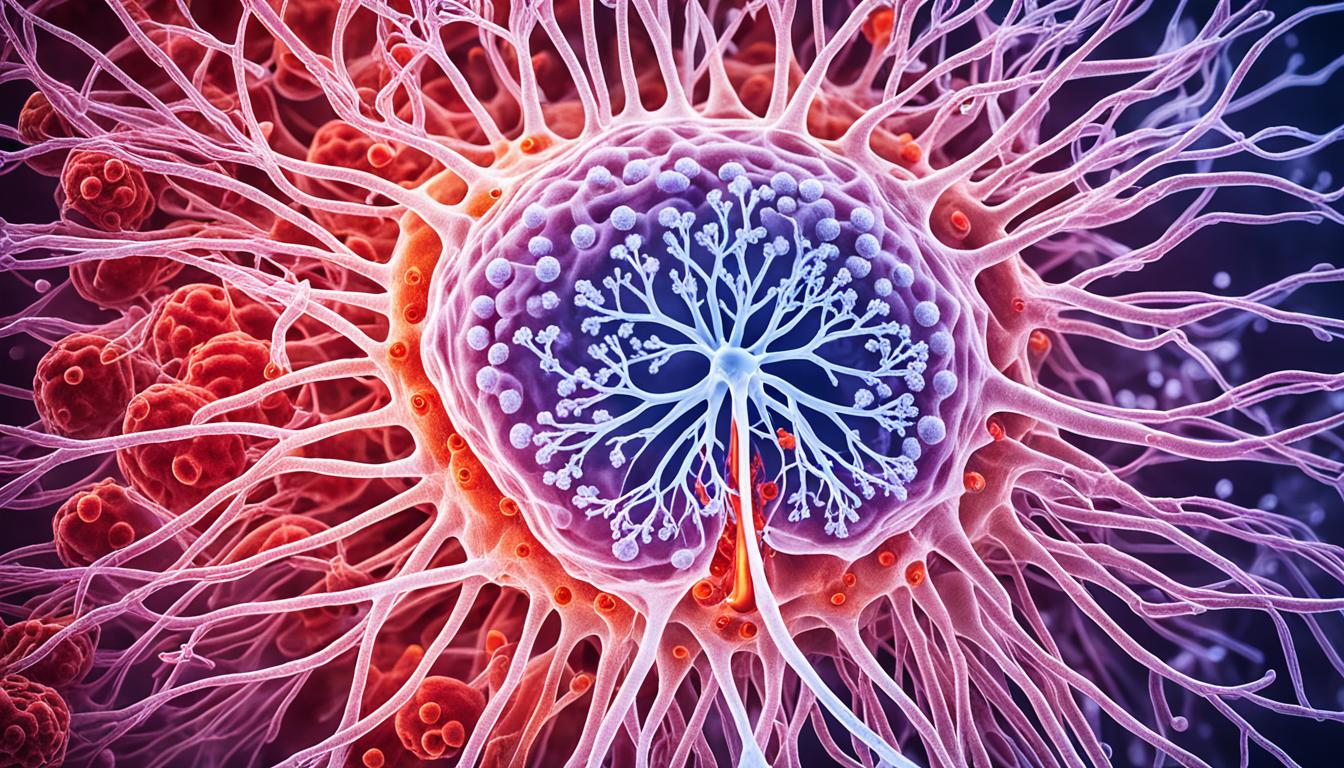Respiratory syncytial virus (RSV) is a common viral infection that affects many people. It hits infants, young children, and adults. This virus leads to cold and flu-like issues, including coughing, a runny nose, and fever. Other symptoms are wheezing, less energy, and feeling unhappy or irritated, especially in kids.
Most people with RSV feel better within one to two weeks. But, some, like very young or older folks, might develop severe lung infections. These severe cases could need a hospital stay.
There’s no specific drug for RSV. So, doctors work on easing the symptoms. Preventing its spread is crucial. Wash your hands well, stay away from sick people, and avoid spreading it.
In some serious RSV cases, stem cell therapy might help. But remember, this is not the usual treatment.
Key Takeaways:
- RSV affects kids, older adults, and others.
- Its symptoms feel like a cold or the flu, with coughing and fever.
- It can cause bad lung infections, needing hospital care.
- Treating RSV means managing its symptoms as antibiotics don’t work on it.
- To stop RSV, keep your hands clean and avoid sick people.
- Sometimes, stem cell therapy is an option for really severe RSV cases.
Symptoms and Transmission of RSV
It’s key to know the symptoms and how RSV spreads. Signs can feel like a cold or flu. These may include coughing and a runny nose. You might also have a fever, wheezing, or feel very tired.
RSV is seriously contagious. It moves through the air when someone coughs or sneezes. So, being too close to an infected person is risky. Plus, you can also get RSV by touching something contaminated and then your face.
| Transmission | Timeline |
|---|---|
| Respiratory droplets | When an infected person coughs or sneezes |
| Surface contact | Touching contaminated surfaces and then touching the face |
The virus takes 2 to 8 days to show symptoms after being caught. But, you can still spread it during this silent period. After symptoms start, it can be caught from you for 3 to 8 more days.
Kids often get RSV at school. They can then spread it to their family. This cycle can affect everyone at home.
Preventing RSV Transmission
Stopping RSV’s spread needs some important steps:
- Wash your hands a lot with soap and water. Do it for 20 seconds or more, especially before eating and after going to the bathroom.
- Stay away from people who are coughing or sneezing a lot.
- Cover your mouth and nose when you cough or sneeze with a tissue or your elbow.
- Safely throw away used tissues.
- Keep things that many people touch, like doorknobs and phones, clean.
- If you feel sick, stay home. This is very important if you’re feeling like you have the flu.
Following these steps can help you stay safe from RSV. It’s especially crucial to protect those who are at higher risk, like babies and older adults.
Diagnosis and Treatment of RSV
To detect respiratory syncytial virus (RSV), doctors look at the person’s symptoms and past illnesses. They may also test a nasal swab or blood for the virus. This way, they can be sure what they are dealing with and give the right treatment.
There’s no special drug for RSV yet. So, doctors focus on easing symptoms and offering care. Medicines like pain relievers and fever reducers can make people feel better. This goes for both kids and grown-ups dealing with RSV.
However, some cases are more serious. Babies and people who are already sick might need to go to the hospital. There, doctors watch their breathing and give extra oxygen or help them breathe.
Getting help early is key to avoid RSV’s serious effects. It can lead to tough lung problems like pneumonia or bronchiolitis. Sometimes, these issues are very dangerous. Acting fast could save a life.
Preventive Measures
To stop RSV from spreading, prevention is vital. By doing simple things like washing hands, avoiding sick people, and cleaning well, we protect ourselves and others. This is especially important for babies and older folks.
- Regular handwashing with soap and water for at least 20 seconds
- Avoiding close contact with individuals who have respiratory infections
- Practicing proper respiratory hygiene, such as covering the mouth and nose while coughing or sneezing
- Keeping commonly touched surfaces clean and disinfected
- Staying home when experiencing symptoms of respiratory illness
Following these steps can slow down RSV’s spread. It keeps our communities safer. Plus, it safeguards our health and the health of those we care about.
Though RSV is worrisome, knowing how to spot it early and what to do next helps a lot. This knowledge lets us take charge of our health and the health of our families. With the right info and actions, we can combat RSV’s threats better.
Conclusion
Respiratory syncytial virus (RSV) is a common illness that targets everyone. Yet, it’s most risky for babies, kids, and the elderly. Most of the time, it brings mild troubles, but it can lead to severe sickness in some.
To stop RSV from spreading, it’s crucial to do some simple things. Regularly washing your hands, staying home when you’re not feeling well, and avoiding close contact with sick people help a lot. These steps lower the chances of catching or spreading the virus.
When someone has RSV, the goal is to ease their symptoms and take good care of them. For mild cases, you can use some common drugs to feel better. But if things get severe, like for tiny babies or those with health issues, they might need to go to the hospital.
As scientists learn more, new ways to beat RSV are on the horizon. Things like stem cell therapy could change how we fight severe cases. This means better care and results for people dealing with RSV.

